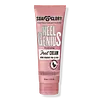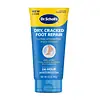What's inside
What's inside
 Key Ingredients
Key Ingredients

 Benefits
Benefits

 Concerns
Concerns

 Ingredients Side-by-side
Ingredients Side-by-side

Water
Skin ConditioningGlycerin
HumectantCetearyl Alcohol
EmollientIsononyl Isononanoate
EmollientCetyl Alcohol
EmollientUrea
BufferingPhenoxyethanol
PreservativeParfum
MaskingMacadamia Integrifolia Seed Oil
Skin ConditioningMenthyl Lactate
MaskingDisodium EDTA
Oleic/Linoleic/Linolenic Polyglycerides
EmollientMethylparaben
PreservativeAcrylates/C10-30 Alkyl Acrylate Crosspolymer
Emulsion StabilisingVaccinium Myrtillus Fruit/Leaf Extract
AstringentPropylparaben
PreservativeDipropylene Glycol
HumectantSodium Cetearyl Sulfate
CleansingSodium Lauryl Sulfate
CleansingAllantoin
Skin ConditioningMenthol
MaskingSaccharum Officinarum Extract
MoisturisingSodium Hydroxide
BufferingBenzyl Salicylate
PerfumingLinalool
PerfumingHexyl Cinnamal
PerfumingCitrus Aurantium Dulcis Fruit Extract
MaskingCitrus Limon Fruit Extract
MaskingLimonene
PerfumingAcer Saccharum Extract
Skin ConditioningPolyoxymethylene Urea
Geraniol
PerfumingDisodium Phosphate
BufferingDipotassium Phosphate
BufferingCI 42090
Cosmetic ColorantCI 19140
Cosmetic ColorantWater, Glycerin, Cetearyl Alcohol, Isononyl Isononanoate, Cetyl Alcohol, Urea, Phenoxyethanol, Parfum, Macadamia Integrifolia Seed Oil, Menthyl Lactate, Disodium EDTA, Oleic/Linoleic/Linolenic Polyglycerides, Methylparaben, Acrylates/C10-30 Alkyl Acrylate Crosspolymer, Vaccinium Myrtillus Fruit/Leaf Extract, Propylparaben, Dipropylene Glycol, Sodium Cetearyl Sulfate, Sodium Lauryl Sulfate, Allantoin, Menthol, Saccharum Officinarum Extract, Sodium Hydroxide, Benzyl Salicylate, Linalool, Hexyl Cinnamal, Citrus Aurantium Dulcis Fruit Extract, Citrus Limon Fruit Extract, Limonene, Acer Saccharum Extract, Polyoxymethylene Urea, Geraniol, Disodium Phosphate, Dipotassium Phosphate, CI 42090, CI 19140
Water
Skin ConditioningUrea
BufferingBeeswax
Emulsion StabilisingCaprylic/Capric Triglyceride
MaskingLanolin
EmollientCetyl Alcohol
EmollientGlyceryl Stearate
EmollientMalic Acid
BufferingPEG-100 Stearate
Lactic Acid
BufferingSodium Hydroxide
BufferingMagnesium Sulfate
Phenoxyethanol
PreservativeSilk Amino Acids
HumectantTocopheryl Acetate
AntioxidantParfum
MaskingAllantoin
Skin ConditioningDisodium EDTA
Ethylhexylglycerin
Skin ConditioningMentha Piperita Oil
MaskingLavandula Angustifolia Oil
MaskingMentha Arvensis Leaf Oil
MaskingMentha Spicata Herb Oil
PerfumingEucalyptus Globulus Leaf Oil
PerfumingWater, Urea, Beeswax, Caprylic/Capric Triglyceride, Lanolin, Cetyl Alcohol, Glyceryl Stearate, Malic Acid, PEG-100 Stearate, Lactic Acid, Sodium Hydroxide, Magnesium Sulfate, Phenoxyethanol, Silk Amino Acids, Tocopheryl Acetate, Parfum, Allantoin, Disodium EDTA, Ethylhexylglycerin, Mentha Piperita Oil, Lavandula Angustifolia Oil, Mentha Arvensis Leaf Oil, Mentha Spicata Herb Oil, Eucalyptus Globulus Leaf Oil
 Reviews
Reviews

Ingredients Explained
These ingredients are found in both products.
Ingredients higher up in an ingredient list are typically present in a larger amount.
Allantoin is a soothing ingredient known for its protective and moisturizingg properties. Because of this, it is often added to products with strong active ingredients.
Studies show higher concentrations of this ingredient can promote wound healing.
Though it can be derived from the comfrey plant, allantoin is produced synthetically for cosmetic products to ensure purity.
Learn more about AllantoinCetyl Alcohol is a fatty alcohol. Fatty Alcohols are most often used as an emollient or to thicken a product.
Its main roles are:
Though it has "alcohol" in the name, it is not related to denatured alcohol or ethyl alcohol.
The FDA allows products labeled "alcohol-free" to have fatty alcohols.
Learn more about Cetyl AlcoholDisodium EDTA plays a role in making products more stable by aiding other preservatives.
It is a chelating agent, meaning it neutralizes metal ions that may be found in a product.
Disodium EDTA is a salt of edetic acid and is found to be safe in cosmetic ingredients.
Learn more about Disodium EDTAParfum is a catch-all term for an ingredient or more that is used to give a scent to products.
Also called "fragrance", this ingredient can be a blend of hundreds of chemicals or plant oils. This means every product with "fragrance" or "parfum" in the ingredients list is a different mixture.
For instance, Habanolide is a proprietary trade name for a specific aroma chemical. When used as a fragrance ingredient in cosmetics, most aroma chemicals fall under the broad labeling category of “FRAGRANCE” or “PARFUM” according to EU and US regulations.
The term 'parfum' or 'fragrance' is not regulated in many countries. In many cases, it is up to the brand to define this term.
For instance, many brands choose to label themselves as "fragrance-free" because they are not using synthetic fragrances. However, their products may still contain ingredients such as essential oils that are considered a fragrance by INCI standards.
One example is Calendula flower extract. Calendula is an essential oil that still imparts a scent or 'fragrance'.
Depending on the blend, the ingredients in the mixture can cause allergies and sensitivities on the skin. Some ingredients that are known EU allergens include linalool and citronellol.
Parfum can also be used to mask or cover an unpleasant scent.
The bottom line is: not all fragrances/parfum/ingredients are created equally. If you are worried about fragrances, we recommend taking a closer look at an ingredient. And of course, we always recommend speaking with a professional.
Learn more about ParfumPhenoxyethanol is a preservative that has germicide, antimicrobial, and aromatic properties. Studies show that phenoxyethanol can prevent microbial growth. By itself, it has a scent that is similar to that of a rose.
It's often used in formulations along with Caprylyl Glycol to preserve the shelf life of products.
Sodium Hydroxide is also known as lye or caustic soda. It is used to adjust the pH of products; many ingredients require a specific pH to be effective.
In small amounts, sodium hydroxide is considered safe to use. However, large amounts may cause chemical burns due to its high alkaline.
Your skin has a natural pH and acid mantle. This acid mantle helps prevent harmful bacteria from breaking through. The acid mantle also helps keep your skin hydrated.
"Alkaline" refers to a high pH level. A low pH level would be considered acidic.
Learn more about Sodium HydroxideUrea is also called carbamide and is the diamide of carbonic acid. In cosmetics, urea is used to hydrate the skin. It also provides exfoliation in higher concentrations.
As a humectant, urea helps draw moisture from the air and from deep within the skin. This helps hydrate your skin. Studies show urea is an effective moisturizer for dry skin conditions. 40% urea is typical in medications for treating eczema and other skin conditions.
Urea has the strongest exfoliation effect in concentrations higher than 10%. It is a keratolytic agent, meaning it breaks down the keratin protein in the top layer of skin. This helps remove dead skin cells and flaking skin.
In medicine, urea has been shown to help increase the potency of other ingredients, such as fungal treatments.
Humans and animals use urea to metabolize nitrogen-containing compounds. Urea is highly soluble in water. Once dissolved, it is neither acidic nor alkaline.
Learn more about UreaWater. It's the most common cosmetic ingredient of all. You'll usually see it at the top of ingredient lists, meaning that it makes up the largest part of the product.
So why is it so popular? Water most often acts as a solvent - this means that it helps dissolve other ingredients into the formulation.
You'll also recognize water as that liquid we all need to stay alive. If you see this, drink a glass of water. Stay hydrated!
Learn more about Water